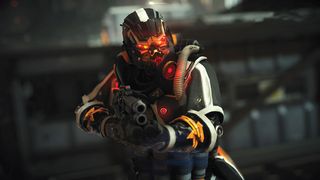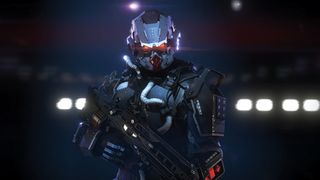Top digital artist redesigns iconic videogame character
Efgeni Bischoff explains how he gave Killzone's iconic assault trooper character a complete makeover.

Efgeni Bischoff is a 29-year-old, freelance artist from Germany, whose 3D assets have graced best-selling games including Crysis and Halo 4. His most recent high-profile job involved freelancing for Guerrilla Games, the Amsterdam-based, Sony-owned studio responsible for the best-selling Killzone franchise. The artist contributed both character and vehicle designs for the recently released PlayStation 4 launch title Killzone: Shadow Fall.
"My favourite asset from the game has to be the Assault Trooper," says Bischoff. "There are many reasons why, but the primary one is that it gave me a chance to redesign the original iconic character from the Killzone game."
My favourite asset from the game has to be the Assault Trooper
The starting point for a character such as this is a rigorously built mock-up mesh, says Bischoff. "I build that before I even decide on the approach I will take with the build. This mesh contains all the important aspects of the design and colour direction from the concepts, and can be used with a rig for initial in-game tests.
"After this, the modelling process is only about increasing the resolution of the character. All design questions should have been answered. By taking this approach, it helps me to quickly make both the high-poly version and then the low-poly one a little later."
Anatomy of an Assault Trooper

Future designs
Bischoff reworked the Assault Trooper to reflect the fact that the latest game is set 30 years after the events of Killzone 3, putting a more angular and futuristic spin on an original design, which itself was influenced by World War 2 uniforms, helmets and armour.
Armoured extras
The new Assault Trooper design goes heavy with solid armour pieces fitted over a ribbed fabric uniform. “My cloth work definitely improved working on Killzone: Shadow Fall,” says Bischoff. “I actually learned a lot about myself, too. It was a really great experience.”
Hardsurface modelling
"The latest version of ZBrush means that hardsurface modelling isn't so hard any more, however, even when I do use it alot, I still love to work with a base mesh built in a classic poly way," says Bischoff. "In fact, most of my base meshes look like final models."
Using niche tools
"Along with the more familiar 3D programs - 3ds Max, Maya, ZBrush and Mudbox - I also use a range of smaller tools including Topogun for topology and xNormal for baking normal maps," says Bischoff.
Adding interest
"A great way to add further model detail is by using floaters - small pieces that instance on top of the main mesh, though with a lot of the Killzone characters I simply used ZBrush to add hardsurface details," explains Bischoff.
Words: Mark Ramshaw
This article originally appeared in 3D World magazine issue 177.

Thank you for reading 5 articles this month* Join now for unlimited access
Enjoy your first month for just £1 / $1 / €1
*Read 5 free articles per month without a subscription

Join now for unlimited access
Try first month for just £1 / $1 / €1
Get the Creative Bloq Newsletter
Daily design news, reviews, how-tos and more, as picked by the editors.
The Creative Bloq team is made up of a group of design fans, and has changed and evolved since Creative Bloq began back in 2012. The current website team consists of eight full-time members of staff: Editor Georgia Coggan, Deputy Editor Rosie Hilder, Ecommerce Editor Beren Neale, Senior News Editor Daniel Piper, Editor, Digital Art and 3D Ian Dean, Tech Reviews Editor Erlingur Einarsson and Ecommerce Writer Beth Nicholls and Staff Writer Natalie Fear, as well as a roster of freelancers from around the world. The 3D World and ImagineFX magazine teams also pitch in, ensuring that content from 3D World and ImagineFX is represented on Creative Bloq.
